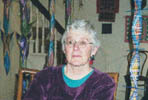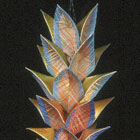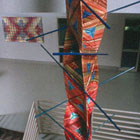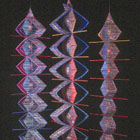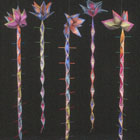PRISCILLA KEPNER SAGE
artwork | audio | statement | galleries
artwork
audio 
(see also Making Art in Iowa and Art & Spirituality)
- Childhood (52 sec. | 353KB): listen | read
- Early art (60 sec. | 410KB): listen | read
- 1960s (59 sec. | 403KB): listen | read
- Children (52 sec. | 357KB): listen | read
- Building (54 sec. | 370KB): listen | read
- Being an artist (55 sec. | 376KB): listen | read
artist statement
While the form of my sculpture has its roots in the universal rhythms, patterns and harmonies of nature, the materials and techniques I use have been developed to amplify and unify that idea source.
Light in weight, the sculture is suspended from one point enabling it to move by natural air currents in space. This movement causes the relationships of the many layered forms to constantly change. The color is achieved by painting disperse dyes in their transparent form on paper and heat transfereing the dyes to silver mylar fabric. Every mark, texture, line, and layer of overlapped color transfers to the fabric. Through this process the surface of the fabric develops a metallic iridescent quality. Light and shadow as well as the colors reflecting on each other cause the colors to subtly change as the sculpture moves, and optical illusions to occur.
The form of the sculpture is constructed by machine and hand stitching the fabric with a polyurethane interior. The wall relief pieces use the same materials and techniques but rely on optical illusion and the movement of the observer to change the pattern and compositional stucture of the work.
audio text
Childhood
My mother graduated from Cedar Crest College in 1930, and really was a woman who was very professionally active for her whole life. She was a woman who always said to her daughters, "You can be anyone, go anyplace, do anything you want to do. And don't get married too early, because you really want to do these exciting things before you get tied down." That was a broken tape in our household. There was never a question as far as my mother, that if I liked art, I would be an artist.
I loved to play. I just loved being a child in that sense of freedom and discovery and so on, and I disliked school very much. The reason was, I did not like the structure. I had such a good time by myself, that having this structure was a real problem for me, and it really was a problem for a long time.
Early art
The art was really very major in my life. It really always was. I mean, I always built and I always drew. I was very fortunate because my family—they were excited that I loved to draw, and so they provided me with art supplies. And my grandmother was an artist, so she thought it was grand. My parents always had a room where I could work; there was always space where I could work. So as a little child, I went to that space and I drew and I painted and I cut out stuff and I built.
I had a second-grade teacher, who I disliked a lot, but I drew a figure just like a child would and there was sort of a tent-like skirt, and then two feet that were at the corners of the triangle. And she told me legs didn't grow that way. But I was a very confident person, I sort of went, What does she know? That's where my feet go. But then when I got older, I was getting a lot of recognition for what I could do in art.
1960s
In 1960, women were not working. And they were staying home and they were filling their time with drinking coffee and doing women's club work and stuff like that. I was approached about doing those activities, and I had no interest in that. I really spent all day, every day, doing my own work. So, in that sense, it was a very, very important time for me, because I learned how much I really wanted to do it.
The one constant I have done has been my own work. I've done a lot of things to generate enough of an income to do some support of my family, some support of my work. But I kept that going. It's much easier to say, I'm a professor at Iowa State. That has always been very secondary. It has been keeping the work going that has been important. But society does not understand that. They don't even want to understand that. Because doing this is a roller coaster.
Children
By the time the children came, I was well-established in my work and had exhibited rather widely. I simply kept going. I had probably some of the best exhibits and things after they were born. It worked out for me, because I was using materials they could play with. And if I was dyeing anything I did it while they were napping, or I had college students that came for blocks of time, so that I could work. So I simply kept going.
I think children see things in a fresh new way, and I think if you pay attention to that, you also see things in a fresh new way. It gives a richness, a depth. Because after all, the art you're making is ideas, it's what you're feeling, what you're seeing. You're visually saying something—I mean, you're not saying my children are influencing me, but you have to be sensitive to what's going on.
Building
Basically, I'm a builder. I'm very intrigued with building. I'm very pure in terms of design concepts; I play around with those a lot. I see fiber as line. The form is very important. I build many, many models to get to the form. In a very pure sense, that's what I'm intrigued with. I mean, I am intrigued with the space between those rods, I am intrigued with the curve of that form, and the color sequencing. And I think that that's enough. But indeed, I think those curves and the way they converge and what they do in that space really comes from my body, that comes from my mind, that comes from my thinking. When I build a piece, there is this structure that really has a relationship to structures in nature, to natural forms.
Being an artist
In a sense, you get to a point where you have to listen so deeply to your own drummer. If you're going to make art that has significance, you have to really look like no one else. This has to be you; it has to have your signature. And so you constantly have to be learning to listen to what you're thinking. You have to really taste it and want to do it. You have to work hard, but you have to have some ability and you have to have an enormous amount of drive certainly without financial rewards.
Being in the arts is hard. But the reason you're in it is because it's so deeply, profoundly rewarding. It allows you to be who you want to be as a human being, and boy, that's worth a lot. I mean, when you can spend your whole life doing that, that's pretty remarkable however you do it.

